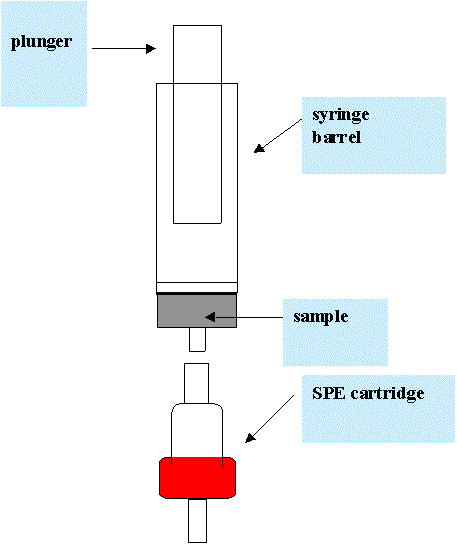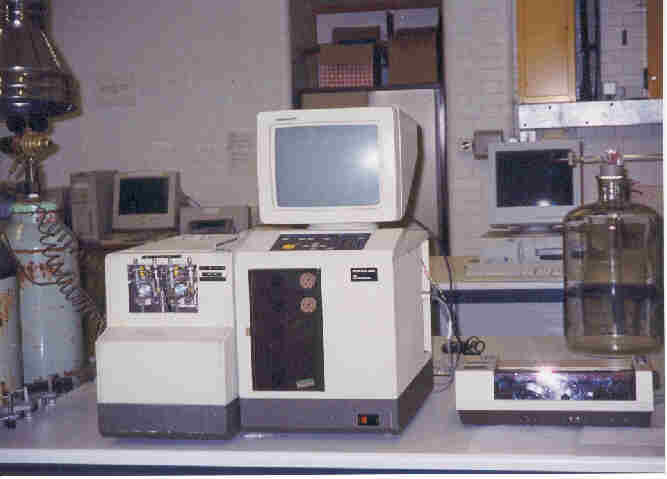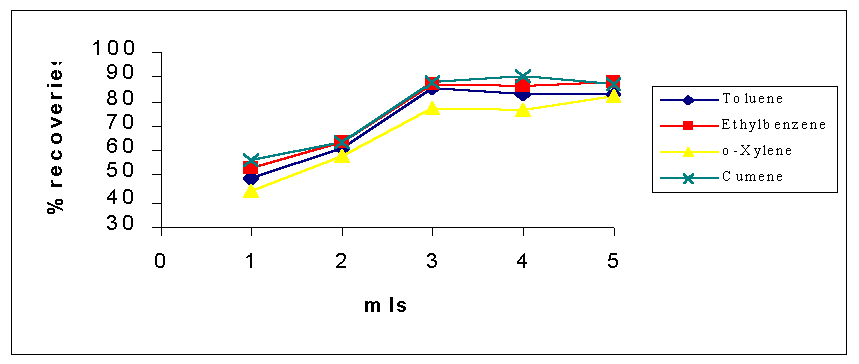INTRODUCTION
- Volatile organic compounds (VOCs) are a cause of concern for
human health due to their increased presence in the indoor
environment.
- They are responsible
for a phenomenon known as
the sick building syndrome (SBS).
- Air monitoring is being used
to assess indoor pollution.
- Solid phase extraction (SPE) procedures are used extensively for
trapping and removing VOCs from indoor air.
|

|
AIM
- The aim of this work is to develop a method for the
determination of the VOCs toluene , ethylbenzene , o-xylene and
cumene (TEXC) in air. VOCs are extracted using solid phase
extraction cartridges and the extracts are then analysed and
quantified using a gas chromatograph with flame ionisation
detection (GC-FID).
|

Figure 1 : A schematic diagram of the SPE apparatus.
|
SPE Procedure
- The cartridge was conditioned and washed with 3 mL of methanol.
- The system was then equilibrated with 3 mL of 50:50 solution
methanol:water.
- 3 mL of a standard solution containing 100 µg mL-1 of all analytes
in methanol:water were loaded onto the cartridge.
- The analytes were eluted with 3 mL of dichloromethane (DCM)
into a 5 mL volumetric flask.
- 100 µL of a dichlorobenzene (DCB) external solution was added
to the extract giving a DCB concentration of approximately
80 µg mL -1.
- The extract was analysed and quantified using GC-FID.
- The cartridges that were used during the SPE method were
Waters C18 cartridges and Anasorb CSC coconut shell charcoal
cartridges.
|

|
INSTRUMENTATION
PERKIN - ELMER 8500 Gas Chromatograph
PERKIN - ELMER GP - 100 graphics printer
|
RESULTS AND DISCUSSION
- Standard solutions of different concentrations containing all
analytes and DCB in DCM were prepared in order to investigate
the linear calibration range. The GC response was found to be
linear up to 400 µg mL -1.
- The minimum elution volume of DCM required to desorb
all of the analytes from the sorbent was found to be 3 mL

Figure 3: Recoveries for analytes using Activated Charcoal cartridges in different elution volumes.

Figure 4: Recoveries for analytes using C18 cartridges in different elution volumes.
- The SPE method was found to be precise at the optimum conditions by
performing 4 replicate extractions.
Table 1: Recoveries for all analytes using C18 cartridges.
| Analytes
| % Recoveries
|
|
Toluene
| 91
| 92
| 88
| 92
| |
Ethylbenzene
| 93
| 91
| 90
| 94
| |
o-Xylene
| 98
| 91
| 96
| 96
| |
Cumene
| 92
| 92
| 96
| 94
|
-
Cartridges were found to be reliable even after repeated use. Recoveries of approximately
> 90 % for each analyte were obtained for cartridges used 10 times previously. After each
experiment cartridges were cleaned by washing with DCM.
- Stability of the VOCs retained in the SPE cartridges was investigated over time. Immediately
after preparation, the analyte recoveries were approximately 95 % and 85 % for C18 and
activated charcoal cartridges, respectively. In room temperature significant loss of analytes
was obtained for both cartridges. Even when the cartridges were stored at -4°C, recoveries of
approximately 60 % were obtained after 30 days suggesting that new methods of storage will
have to be developed.
Table 2 : Recoveries of analytes for cartridges stored in -4°C.
| % Recoveries |
| |
C18 Cartridges |
Activated Charcoal Cartridges |
|
Analytes
| after 1 day
| after 2 days
| after 30 days
| after 1 day
| after 2 days
| after 30 days
| |
Toluene
| 92
| 88
| 56
| 72
| 64
| 47
| |
Ethylbenzene
| 95
| 90
| 63
| 76
| 68
| 51
| |
o-Xylene
| 99
| 95
| 65
| 60
| 58
| 43
| |
Cumene
| 100
| 96
| 75
| 80
| 73
| 60
|
Table 3 : Recoveries of analytes for cartridges stored in room Temperature.
| % Recoveries |
| |
C18 Cartridges |
Activated Charcoal Cartridges |
|
Analytes
| after 1 day
| after 2 days
| after 1 day
| after 2 days
| |
Toluene
| 85
| 81
| 54
| 48
| |
Ethylbenzene
| 89
| 83
| 58
| 57
| |
o-Xylene
| 93
| 91
| 45
| 44
| |
Cumene
| 94
| 92
| 62
| 60
|
|
CURRENT AND FUTURE WORK
-
The SPE procedure developed
in this work is currently being assessed for analytes
in the vapour phase. An environmental chamber has
been constructed to obtain VOC contaminated air, and
an active sampling pump
is used to drew the air over
the C18 and activated charcoal cartridges.
-
Remedial technologies are also
being addressed. New crystalline silicates are being
designed , synthesised and tested for the removal of VOCs
from contaminated air.
|

|
|